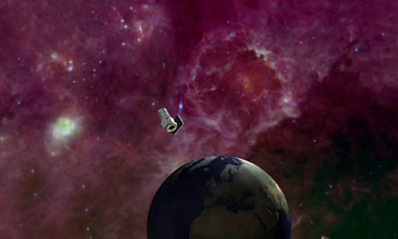


|

|
 |
|
WISE chilled out, ready for launch DR EMILY BALDWIN ASTRONOMY NOW Posted: November 19, 2009 The Wide-field Infrared Survey Explorer WISE is chilled out and ready to roll onto the launch pad tomorrow, ahead of its planned 9 December launch into space to survey the entire sky in infrared light. “WISE is chilled out,” says William Irace, the project manager at JPL. “We’ve finished freezing the hydrogen that fills two tanks surrounding the science instrument. We’re ready to explore the universe in infrared.”  Artist impression of NASA's WISE spacecraft mapping the sky in infrared. WISE will launch no earlier than 9 December. Image: Ball/NASA/JPL-Caltech. Artist impression of NASA's WISE spacecraft mapping the sky in infrared. WISE will launch no earlier than 9 December. Image: Ball/NASA/JPL-Caltech.
The spacecraft is chilled to ultra-cool temperatures of less than eight kelvin, so that it doesn't give off any heat of its own that could contaminate these sensitive observations. WISE will enter a polar orbit around the Earth, scanning the entire sky one and a half times in nine months in four infrared wavelengths. The mission is set to uncover hidden cosmic objects including the coolest stars, dark asteroids, and the most luminous galaxies, cataloging hundreds of millions of objects that will serve as navigation charts for other missions including Hubble, Spitzer and JWST. “This is an exciting time for space telescopes,” says Jon Morse, NASA’s Astrophysics Division director. “Many of the telescopes will work together, each contributing different pieces to some of the most intriguing puzzles in our Universe.” Infrared observations allow astronomers to probe cold, dusty or distant objects. In our own Solar System WISE is expected to find hundreds of thousands of cool asteroids – including hundreds that pass relatively close to the Earth – providing better estimates of asteroid sizes and compositions. “With infrared, we can find the dark asteroids other surveys have missed and learn about the whole population. Are they mostly big, small, fluffy or hard?” says WISE project scientist Peter Eisenhardt. This data will help astronomers learn more about potentially hazardous impacts on the Earth. WISE will also track down the coolest 'failed' stars, known as brown dwarfs, including one that could be lurking in our neighbourhood, even closer than the nearest known star Proxima Centauri, which is four light-years away. If it does exist, WISE will be able to pick up its glow. The mission will also seek out dusty cocoons of stars and swirling planet-forming discs, and may even lay claim to the most luminous galaxy in the Universe. To learn more about the WISE mission, check out our article The old, the cold and the dusty in the December issue of Astronomy Now magazine. |
|
|
|
|